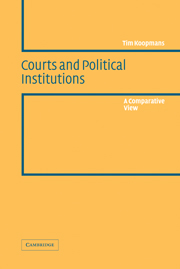Book contents
- Frontmatter
- Contents
- Preface
- Table of cases
- List of abbreviations
- 1 Introduction
- 2 The Sovereignty of Parliament
- 3 Judicial review of legislation
- 4 The growth of judicial power
- 5 The limits of judicial review
- 6 The legality of administrative action
- 7 Courts and governments
- 8 Courts and individual rights
- 9 Techniques of judicial protection
- 10 A glance at the future
- Select bibliography
- Index
- Frontmatter
- Contents
- Preface
- Table of cases
- List of abbreviations
- 1 Introduction
- 2 The Sovereignty of Parliament
- 3 Judicial review of legislation
- 4 The growth of judicial power
- 5 The limits of judicial review
- 6 The legality of administrative action
- 7 Courts and governments
- 8 Courts and individual rights
- 9 Techniques of judicial protection
- 10 A glance at the future
- Select bibliography
- Index
Summary
Terminology
This book examines the legal relations between political institutions and the courts in some European countries and in the United States. The author happens to be interested in this theme and, particularly, in the boundaries between judicial and political activities.
At first sight, it is a somewhat unlikely subject. There seems to be little that judges and politics have in common. The dry atmosphere of the courtroom cannot be compared to the vividness of a debate in – say – the House of Commons or the American Senate. Judges are normally represented as somewhat elderly gentlemen, who try to look as wise as they are supposed to be; a gown and (in the case of English judges) a wig will strengthen that impression. Politicians, by contrast, radiate a cheerful kind of optimism, illustrated by a happy smile or a determined look on their faces; the image they evoke is one of willingness to tackle any problem humankind may find in its way. Two different worlds, one would be inclined to say. However, appearances are deceptive. I hope to show that it is far from easy to determine the borderline between the scope of judicial and political activities. To complicate things further, differences between legal systems also concern the exact location of this borderline. What is ‘political’ in some systems, for example in English law, may be the kind of problem to be solved by the courts in a different system, for example, under the Constitution of the United States.
- Type
- Chapter
- Information
- Courts and Political InstitutionsA Comparative View, pp. 1 - 14Publisher: Cambridge University PressPrint publication year: 2003

